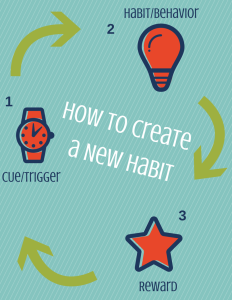We’ve all heard the mantra “It takes 3 weeks to make or break a habit” but we all know that habits are not going to change themselves. Learning the proper techniques can make a actually make or break that new behavior. Let’s look at the…
3 steps to create a new habit
There are 3 components to be clear on when you have a plan to create a new behavior:
- Trigger (or cue)
- New behavior (or habit)
- Reward
Before you begin:
First, I want you to think about a new habit you would like to create. I will use the example of drinking more water for this lesson but you can use your own habit as we learn this technique. Now, because I am a big fan of creating specificity in your goals it might be a good idea to be a little more focused about this habit…In the case of my example, just what does “more” mean? Let’s define that the goal of my new habit is to begin drinking half of my body weight in ounces every day.
Step 1 – Find a trigger
To begin you will need to find a simple, obvious, and reoccurring cue in your day that will be your signal that it is time to perform the new behavior. This will of course depend on what type of behavior you are attempting to create. Is is a one time event in the day or will the new habit occur throughout the day? Of course in my example of drinking more water each day, I wouldn’t want to drink all of the water at one time or I might have bigger issues on my hands than getting more water on board. I might want to set several triggers throughout my day such as setting alarms or using meal times as my cue to drink a specific amount of water. If I am aiming to drink 70 oz of water each day and I eat 4 times a day I can break it down to drinking 17. oz before or after (or both) my meals. This breaks the new behavior down into sippable 😉 amounts. If your new behavior is to perform 10 push ups each day, you may decide to place them right before bed since you go to sleep every single night. Other repeating triggers could be waking up, brushing your teeth, or even an alarm that you have set for the same convenient time each day. Keep in mind that you may have to get creative with triggers depending on what kind of habit you are trying to create.
Step 2 – Perform the new behavior 
Now that the alarm has gone off or you have finished brushing your teeth, it is time to perform the new habit. Just do it. Done. 🙂 That was easy!…If this is a habit your struggle to enjoy, it may not be just that easy but the trigger has done a lot of the work for you. Just remembering that you are doing a new thing is often half the battle right?
Step 3 – Give your brain a reward
The reward portion of this system is really important. We often think about changing habits as being mechanical or something that we just do…or don’t do. But the key to creating these new patterns is to convince the brain that it likes the new event. The brain likes to repeat what it finds satisfying. A sensible reward will help light up the pleasure centers of the brain to drive the brain want to do it more often. It’s all about “waking up” the nervous system pathways that will cause the habit to become a skill that you have soon mastered. Think about a trickle of water running through dirt, a little trench will soon wear a little path and eventually a stream. So it is with your brain and repetition. Soon the new habit will become automatic and you can move your focus on to other healthy choices
Some of my favorite simple rewards and a happy dance, a big smile or a fist pump. I like to create a physical reward because it cements it in the brain.
Here are a few other things to remember about creating new habits:
Multitasking is not your friend: When trying to adopt a new behavior it is best to stick with one change at a time…Check out these stats:
Get a buddy: Some new behaviors are going to need some accountability in order to help you be the most successful. Grab a friend and your chances of success can increase greatly
Add in to crowd out: If you are trying to get rid of an old “bad” habit it might be useful for you to add in some new behaviors to take the place of the old one. Sometimes we can feel deprived and our brain gets sad about it. Create a new focus by adding in something that makes you happy…but still healthy of course
Remove temptation: If your new habit is actually removing an old bad habit, make it as easy to succeed as possible. Do as much as you can to remove temptations and obstacles. If you are making a change toward healthier eating, make the right things to eat, the easiest things to eat.
Write it down: Make these changes more concrete by writing them down. There is something about writing a commitment down that instantly makes you a little more accountable.
Ok! Now yo are armed and dangerous. Pick that habit, set a trigger and create a reward!
If you can identify the right cue and reward—and if you can create a sense of craving—you can establish almost any habit.
Some habits can be really hard to change. Sugar is one of those because there are addictive properties to sugar. If you need help kicking your sugar habit to the curb I’ve written an article to help HERE. If you need MORE help, check out my 5 Day Sugar Detox to gain the power of knowledge and the accountability of daily emails to get you through.




